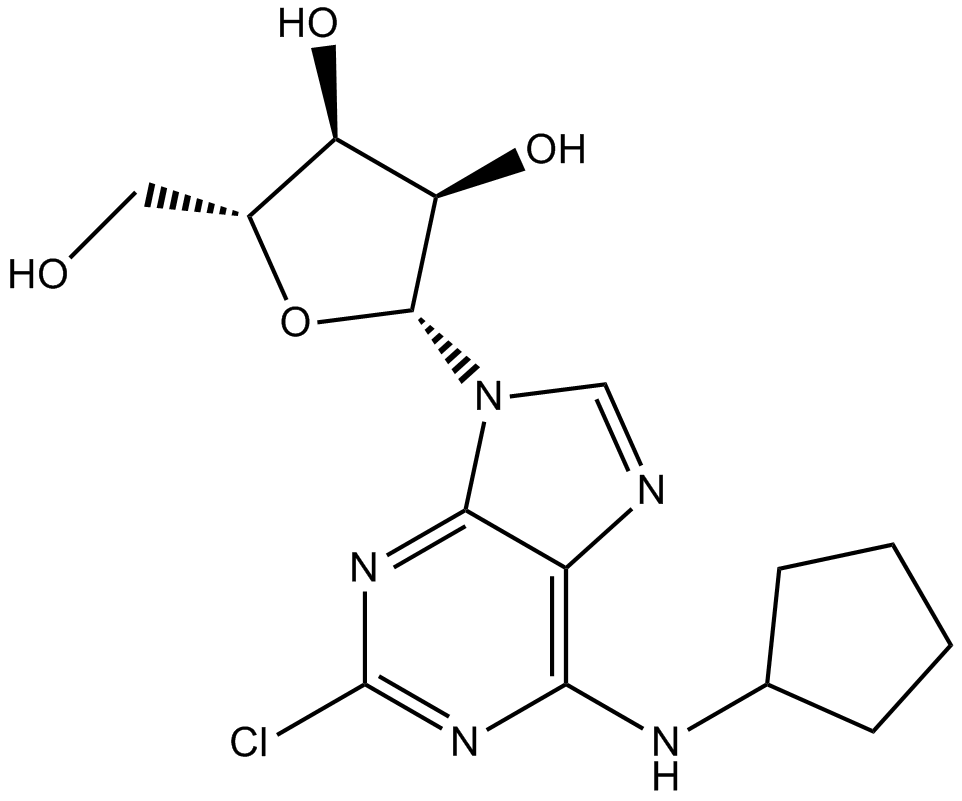2-Chloro-N6-cyclopentyladenosine (Synonyms: CCPA) |
| Katalog-Nr.GC11665 |
adenosine A1 receptor agonist, potent and selective
Products are for research use only. Not for human use. We do not sell to patients.

Cas No.: 37739-05-2
Sample solution is provided at 25 µL, 10mM.
2-Chloro-N6-cyclopentyladenosine is a potent and selective agonist of adenosine A1 receptor [1].
The adenosine A1 receptor is a G protein-coupled receptor for adenosine and plays an important role in sleep promotion.
2-Chloro-N6-cyclopentyladenosine (CCPA) is a potent and selective agonist of adenosine A1 receptor. CCPA inhibited [3H]PIA binding to A1 receptors of rat brain membranes and [3H]NECA binding to A2 receptors of rat striatal membranes with Ki values of 0.4 and 3900 nM, respectively.
Also, CCPA inhibited adenylate cyclase in rat fat cell membranes with IC50 value of 33 nM and stimulated adenylate cyclase activity in human platelet membranes with EC50 value of 3500 nM [1]. In rat and bovine brain, CCPA exhibited high affinity for A1 receptors with Ki values of 1.3 and 0.5 nM, respectively. In spontaneously beating rat atria, CCPA inhibited chronotropic activity with EC50 value of 8.2 nM [2].
In ischemia/reperfusion rat model, CCPA significantly inhibited the rise of coronary perfusion pressure and diastolic pressure [2]. In rabbits, CCPA reduced mean blood pressure by 40-50% and also lowered heart rate [3]. In mice, CCPA (1.4-27.6 µmol/kg) increased [35S]TBPS binding in membranes from the substantia nigra, hippocampus, cerebral cortex and striatum mediated by A1 receptor. CCPA reduced GABA-coupled chloride channel function and induced anticonvulsant activity [4].
References:
[1]. Lohse MJ, Klotz KN, Schwabe U, et al. 2-Chloro-N6-cyclopentyladenosine: a highly selective agonist at A1 adenosine receptors. Naunyn Schmiedebergs Arch Pharmacol, 1988, 337(6): 687-689.
[2]. Monopoli A, Conti A, Dionisotti S, et al. Pharmacology of the highly selective A1 adenosine receptor agonist 2-chloro-N6-cyclopentyladenosine. Arzneimittelforschung, 1994, 44(12): 1305-1312.
[3]. Concas A, Santoro G, Mascia MP, et al. Anticonvulsant doses of 2-chloro-N6-cyclopentyladenosine, an adenosine A1 receptor agonist, reduce GABAergic transmission in different areas of the mouse brain. J Pharmacol Exp Ther, 1993, 267(2): 844-851.
[4]. Sandoli D, Chiu PJ, Chintala M, et al. In vivo and ex vivo effects of adenosine A1 and A2 receptor agonists on platelet aggregation in the rabbit. Eur J Pharmacol, 1994, 259(1): 43-49.
Average Rating: 5 (Based on Reviews and 33 reference(s) in Google Scholar.)
GLPBIO products are for RESEARCH USE ONLY. Please make sure your review or question is research based.
Required fields are marked with *




















